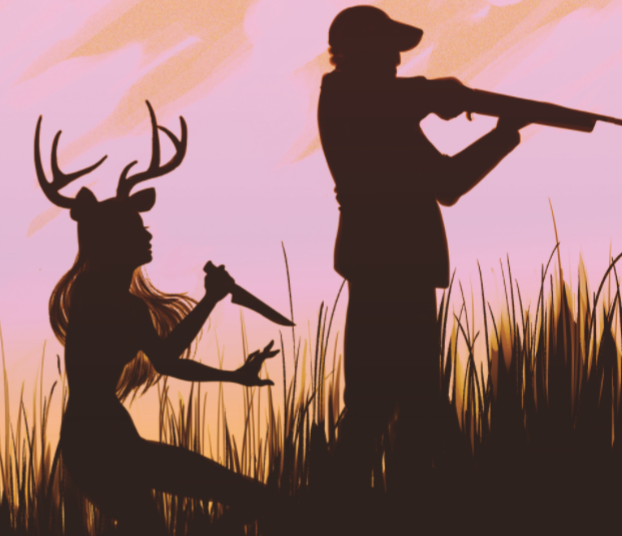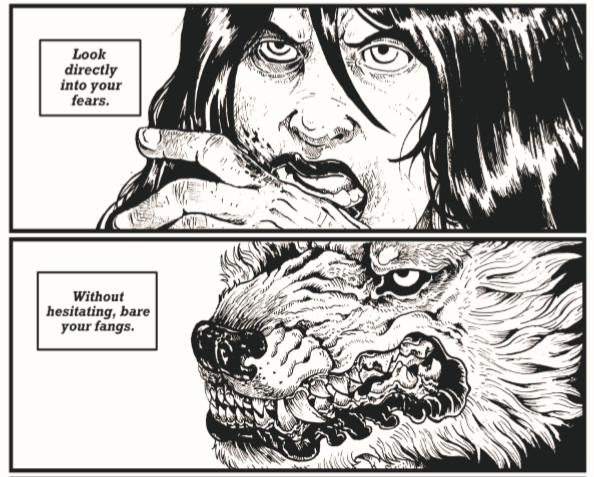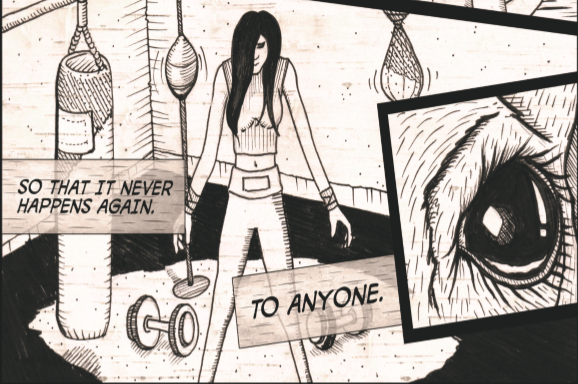
Seeking lessons in how to be a badass? Two books by and about Native women offer detailed assistance: Trail of Lightning, the first book in a new fantasy series by Rebecca Roanhorse, and Deer Woman, an anthology of graphic stories edited by Guggenheim Fellow Elizabeth LaPensée and indie comic artist Weshoyot Alvitre. Lightning is set to be released in June by Saga Press, an imprint of Simon & Schuster, while Deer Woman was assembled by Native Realities, as independent a press as they come. These two books have very different aesthetics, but they share an iron spine: the power of Native women to persevere, and to endure.
Trail of Lightning introduces Maggie Hoskie, a member of the Diné, who outlasted the climate apocalypse that drowned most of the United States. This is the near-future, a time when the new ways are lost and the old ways have returned. Technology, government, white supremacy, all mostly drowned in the “Big Water,” but Coyote walks the land in corporeal form, as do monsters of legend (and a few new creations). Supernatural powers, such as exceptional hearing, super-speed, and healing, evidence themselves through the clan bloodlines of Diné people. Maggie, orphaned under gruesome circumstances, is a monster hunter, and at the book’s opening, she is still recovering from her mentor’s unexplained abandonment. But she must recover quickly. New threats, and new opportunities, appear thick and fast across Dinétah, no longer a reservation, and Maggie must fight monsters out in the world as well as within her own heart.
This summary does not communicate the dynamic, intense pleasure of reading Trail of Lightning. I could have read about Maggie, her badassery, her damage, and her perseverance for hundreds more pages (and I look forward to doing so, when the next Sixth World novel is released). Trail of Lighting’s rich geographical and emotional landscapes make it a cracking good read, clipping along with the pace of the best urban fantasy. Plus, the fact that this supernatural world comes from a meaningful set of traditions, rather than being invented by a single imagination, makes it more rewarding to invest in that world as a reader. Coyote’s clothes and manner are written by Roanhorse, but she is calling on something larger and longer-lived than herself, and that matters.
When I studied Gloria Anzaldúa in grad school, I learned that white people do not have to understand everything. Generally, and especially when it comes to media: reading, television, music. (It took too long for me to figure this out, but I was raised really white.) I don’t know Spanish, which means that there are passages in Borderlands that I must have someone translate for me, or accept as knowledge I’m not entitled to, that I may never understand fully. In this way, Anzaldúa’s medium expresses her message. Living in a dominant culture and coming from a non-dominant culture will make one feel bottomlessly foreign, illegible, untranslatable. Anzaldúa is not obligated to take my hand and make me comprehend her language, and now, my gringa self will have to come to terms with the discomfort that comes along with my lack of understanding, and what that means.
I was prepared for this sensation when I opened Trail of Lightning, but I never once felt it. Roanhorse is incredibly generous with the culture she’s writing about, a culture I am guiltily unfamiliar with. She didn’t have to translate the Navajo words she uses, and she didn’t have to gracefully explain the significance of what feel like foundational aspects of Diné culture. But she did. And I never once had the feeling that she did this begrudgingly, as an obligation to her non-Native readers, but instead that she did it in the spirit of sharing something meaningful with those of us too insulated to know this culture, with Native readers from other tribes, and even with Diné people who may not have grown up hearing much of their language or stories. Even better, it’s a terrific read — meaning and myth in an entertaining package.

Deer Woman is a little less accessible for an unfamiliar audience. I read the anthology once before reading Trail of Lightning and then read it again while preparing this piece, and appropriately enough, I understood a lot of it better after Roanhorse had translated some things for me. For example, the opening graphic piece, based on the Deer Woman story that inspired the anthology, depicts a woman who is sometimes a deer and sometimes not, and it wasn’t clear to me on the first read whether other people saw her literally as a deer or whether she merely saw herself that way. I realized on the second read that it wasn’t either/or. Deer Woman shows up to inspire, offer strength, and sometimes assist in matters of vengeance. She is a spirit, maybe, or a physical creature, maybe, or both, or neither. Like Roanhorse, the writers of the anthology call on a time when discerning between animals and humans was beside the point. For audiences unfamiliar with indigenous storytelling, Deer Woman challenges the non-Native lens through which nature, humanity, and the supernatural — and the lines drawn between them — are conceived.

All of the pieces in this book are stunning, and they vary significantly in style, making the book a wonderful showcase of talent. “Wives,” by Darcie Little Badger and Tara Ogaick is about microaggressions, and its charming style reminds me of middle-grade book illustrations. “Deer Woman” by Maria Wolf Lopez uses intense detail and extraordinary textures to depict wildness, while “Las Aunties,” by Kimberly Dawn Robertson, is composed of decorated, captioned collages. “Equilibrium,” by Mia Casesa, uses only illustration, no text.

The main throughline of the anthology, aside from Deer Woman herself, is the support of women by women. Each story shows women holding each other up, trusting each other, coming through for each other in crisis and on ordinary days. Women must do this for each other in any culture in order to survive, but as the anthology demonstrates, Native women are particularly at risk. The publisher’s introduction notes, “One in three Native women are assaulted in their lifetimes.” High Country News reports even grimmer statistics: “Of over 2,000 women surveyed, 84 percent of Native American and Alaskan Native women have experienced violence, 56 percent have experienced sexual violence, and over 90 percent have experienced violence at the hands of a non-tribal member.” Not to mention the compounded violence against two-spirit people. These awful numbers are part of why Native Realities is donating 10% of profits from the anthology to Arming Sisters Reawakening Warriors, an organization whose mission is “re-empowering and reawakening the mental, physical, spiritual, & emotional health of indigenous communities through self-defense.”

Not every Native woman can be equipped with Maggie Hoskie’s supernatural powers, but Deer Woman shows that the power of Native sisterhood in the present day can be just as potent. The stories these books tell have resonance in many lives, whether Native or not. After all, everyone likes reading about a badass.

Native Women Personify Ass-Kicking in Trail of Lightning and Deer Woman: an Anthology was originally published in Anomaly on Medium, where people are continuing the conversation by highlighting and responding to this story.
